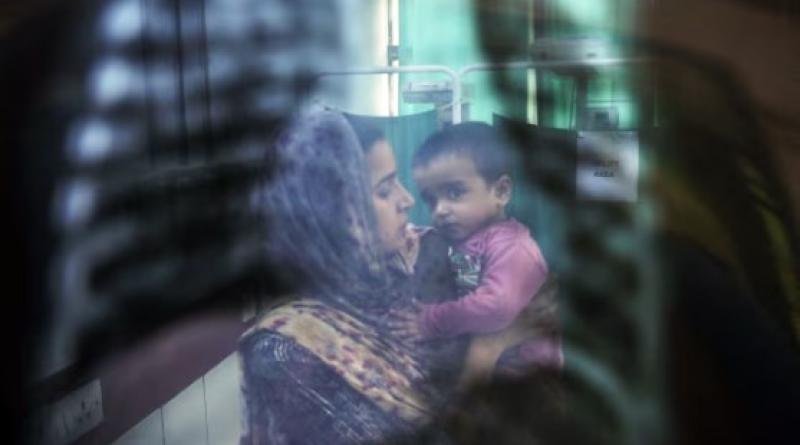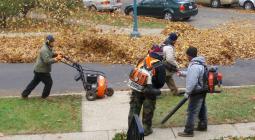India counts cost of another polluting Diwali on a generation of children

One in three children in Delhi is already asthmatic, with many more at risk of organ damage from breathing noxious air. A crowded waiting room at one children’s hospital tells the story
It is the third time in a week that Pankaj Ram, a construction worker, has lost wages because he has had to take his 18-month-old son, Ankit, to hospital, with breathing difficulties. “This time, the doctors say he will probably need to be admitted. The last two times, they gave him an injection,” says Ram.
His wife, Pinki, and her sister squat in the corridor of Kalawati Saran children’s hospital in the Indian capital, New Delhi, while Ram talks to a doctor.
Ram has been told that Ankit is probably asthmatic, though it is too soon to be sure. He is not fully aware of the lethal cocktail of factors that creates horrific levels of pollution in the city, but he does know that Diwali – the Hindu festival of lights that was celebrated on Sunday – has made things worse because he can see a pea soup of smog all around him the day after.
A generation of children is growing up in a city that is, for most of the year, one of the most polluted in the world. Come October and the onset of winter, soaring pollution triggers a public health emergency.
The winters are especially bad because there is little rain or wind to disperse toxins. Farmers in neighbouring states burn their crop residue, sending black smoke wafting into the city. On top of it all comes Diwali, when people burst firecrackers which release chemicals and noxious gases.
This year could have been different. Just before Diwali, it rained, clearing the air, not to “good” but at least to “poor” quality. The air quality index (AQI) stood at 218 (0-50 is considered good but Delhi is so polluted that 218 is deemed pleasant).
Heartened by the “low” AQI, the supreme court braced itself for Diwali by reminding residents of its 2018 nationwide ban on firecrackers. But some of the city’s 33 million residents ignored the ban. By Monday morning, the AQI in many areas had soared to 850.
This week, clinics and hospitals have seen an influx of children, asthmatic and otherwise, coming in wheezing, with smarting eyes, coughs and respiratory problems. “Every year after Diwali, we see a 30% spike in respiratory cases, and many are children because their lungs are more vulnerable to damage,” says Dr Ajay Shukla, medical director at Delhi’s Dr Ram Manohar Lohia (RML) hospital.
Studies by chest surgeon Dr Arvind Kumar have shown that almost one in three children in Delhi is asthmatic. Specialists say that because children are not fully developed, their lungs, brains and other organs are all vulnerable to damage. That is the reason Shukla opened a new pollution outpatients department at RML earlier this month, with specialists in ENT, skin, respiratory tract, eyes and psychiatry on hand.
Why psychiatry? “Pollution can cause mood swings in children, depression and other mental health issues related to being confined indoors,” says Shukla.
At Kalawati Saran hospital, the waiting room is packed with anxious parents rocking babies and toddlers. Nursing officer Renu Das says: “Cases have peaked since Diwali. It’s 3pm now, and we’ve seen 30 children who need nebulising since the morning. When it spikes like this, you know it’s the pollution.”
Asthmatic children who are not in hospital being nebulised or receiving steroid injections, are often confined to their homes by parents who dare not let them out. Doctors say that breathing the air is the equivalent of smoking 25-30 cigarettes a day.
Sabina Raza is waiting with her daughter, Fatima, eight, who has developed a chronic cough. Her fear is that, while Fatima is not asthmatic, she may develop the disease. “I try to keep her indoors to protect her lungs, but it is stressful,” says Raza. “She gets angry when I say she can’t go out and play with friends. She is missing out on fun, but it’s either that or lung problems.”
Doctors regularly issue frightening predictions about what the polluted air will do to children’s health. “In the coming years, children are more likely to get airway disorders like asthma and upper respiratory allergies,” Dr Anant Mohan, pulmonary department head at the All India Institute of Medical Sciences, told India Today magazine.
Here at Kalawati Saran, the doctor on duty, Dr Atul Verma, is already seeing that happen. He has just fitted a nebuliser on a seven-year-old girl who is about the same age as his niece. He has advised his sister to buy a house in the mountains and escape the gas chamber that Delhi has become.
That is not advice he can give to his patients, who are all poor. They come to the hospital because treatment is free. They cannot afford air purifiers or homes in the hills.
Verma says: “I limit what I tell parents. It’s bad enough if their child develops asthma. I cannot tell them about all the other organs that can be affected, the mutations that could be triggered by pollution. Why burden them even more?”
Amid the angst over pollution, the hand-wringing columns and the blame game played by politicians, it was the supreme court that described the catastrophe in the bleakest terms: just before Diwali, the judges called it “the complete murder of our young”.
Photograph: Arun Sankar/AFP/Getty Images - A mother in front of an X-ray of her child’s lungs at the new Chacha Nehru Bal Chikitsalaya hospital after Diwali caused pollution spikes in Delhi.




